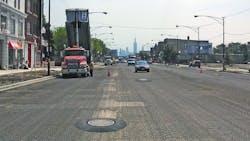In July 2000, the Illinois Department of Transportation (IDOT) sent a letter to Scott Fier, president of American Highway Products, approving the use of his company’s adjustable riser rings when raising utility and manhole rims to grade after pavement lifts. Formal language describing acceptable riser rings was soon included in IDOT’s continually updated Standard Specifications for Road and Bridge Construction (SSRBC).
For example, the April 2016 version says “…the adjustment of frames and grates may be accomplished through the use of adjusting rings that fit on top of the frame. These adjusting rings shall be fabricated as a one-piece assembly from gray iron, ductile iron or structural steel. They shall provide a structural capacity equal to or greater than the existing frame and shall not affect the opening size or surface appearance. The rings shall have a device for positively positioning and fastening the ring to the existing frame to prevent movement under traffic.”
This formal approval by IDOT was significant for Chicago, as it cleared the way for widespread use of adjustable risers in Illinois’ largest city and metro area. “We want contractors in the city to be using quality materials, and the SSRBC is one of the sources we use to define what good solutions really are,” explains Cindy Williams, quality assurance manager for the Chicago Department of Transportation (CDOT). “And generally speaking, quality risers that fasten securely to frames are a good idea—they’re not appropriate in every situation, but where they can be used they should be used. They allow for a less invasive solution and are better for our roadways.”
Williams believes that cuts in the pavement should always be avoided when possible, and in the case of manholes this view is supported by a 2004 Kansas City study titled A Look at the Effect of Manholes on Street Condition, by Steve Rinne, which concluded that pavement was three times more likely to be rated bad around uneven manholes, compared to even manholes. In other words, precisely matching grade and avoiding excavation and patching when raising manholes to grade is a good strategy for extending the service life of new paving.
Of course, cost and convenience also are important. “Risers are faster to install compared to excavating and raising with concrete rings,” Williams says. “So there’s a cost savings benefit, which we address with a specific line item for structure adjustments. And of course we also appreciate reducing the time that lanes are out of service. Good quality adjustable risers that meet the SSRBC specifications and are used appropriately are a win for everyone.”
One make of adjustable riser that meets SSRBC specifications and has been widely used in Chicago is the American Highway Products Pivoted Turnbuckle Manhole Riser. Bigane Paving, one of the city’s major roadway repair contractors, has been using AHP risers since 2007 and installs up to 300 annually. “Everybody fell in love with them, including the city,” says Bigane’s General Superintendent Jim Dillon.
The pivoted turnbuckle riser is a simple steel ring that fits into existing manhole rims. A screwdriver is used to tighten the turnbuckle, exerting thousands of pounds of force to ‘positively position and fasten’ the riser per SSRBC guidelines. Installation takes about five minutes, and since the risers are available in very fine height and diameter increments, it’s easy to exactly match the grade of newly paved surfaces without ripping up and replacing pavement. “That compares to raising the entire manhole structure, which usually means breaking out and replacing a hole 3.5 or 4 ft square and 9 in. deep,” Dillon explains. “And worse, we then have to keep traffic off for three days. With the risers, there’s no delay at all—it’s immediate.”
Bigane Paving and other Chicago contractors often use another AHP product, the Manhole Safety Ramp, to protect risers—and cars—in the period after installation and before paving. The ramps are tapered rubber rings that fit snugly around risers and are used instead of cold mix. The ramps are a much better solution, according to Dillon: “For one thing, they’re reusable,” he explains, “Our crews just throw them over the rims after milling, which takes seconds. And just before paving, our paving crews pick them up and throw them back on a truck.”
Williams agrees. “We don’t have any specifications for riser protection, but I think the rubber ramps are a nice option to have,” she says. “There’s a lot more labor and cleanup with the cold mix, and they seem to be a good way to reduce contractor exposure to car damage liability.”
